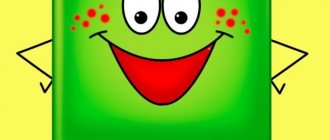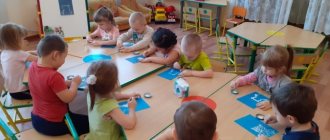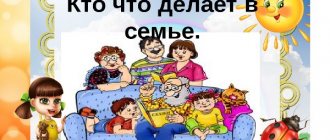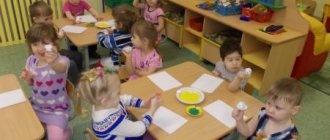Lesson summary on the topic “Big or small”
Bobchenko O.V.
English lesson notes
Topic:
Big or small
Lesson type:
combined
Age:
3-4 years
Target:
practice pronunciation of sounds that cause difficulties for students; repeat and systematize vocabulary on the topic “Animals”; introduce children to the concepts of big and small; introduce new words big, small; introduce children to the new song “Old MacDonald”
Tasks:
- Educational
. Consolidating vocabulary in students’ memory and activating them in oral speech, improving phonetic skills.
- Educational
. Development of speech and cooperation skills. Forming interest in English classes.
- Developmental
. Development of fine motor skills, memory, thinking, concentration. Learning to distinguish objects by size: large - small. Formation of the ability to select and group objects by size. Formation of general communication skills.
Forms of work:
Frontal, individual, group
Teaching methods:
author's technique Shishkova I.A., Verbovskaya M.E.
Equipment.
Toys - animals of different sizes, large and small, balls of different sizes, large and small, vocabulary material, audio recordings, pictures and pencils.
Progress of the lesson
I. Greetings.
-Hello! I am glad to see you.
-Today we will play interesting games and learn a new song.
-Let's stand in a circle and say hello to the Teddy bear.
Children stand in a circle.
The teacher gives each child a teddy bear with the words - Hello, Masha.
The student gives the teddy bear to the teacher and says in response - Hello, Teddy bear!
- How are you?
- Fine, thank you.
II. Phonetic exercise.
Game "Echo"
Goal: establishing correct pronunciation and practicing sounds.
First, the teacher pronounces the sounds in a whisper, and the children must correctly pronounce the pronounced sound. Then the students take turns saying the sounds in a whisper, and the teacher repeats after the students.
III. The main part of the lesson.
- Find and name who hid from the fox.
Goal: repetition of vocabulary on the topic: “Animals”;
The teacher distributes the same picture to the children. They complete the task: Find and say! (Find and name who hid from the fox. Appendix 1)
- Introducing the words big and small
Teacher: Today Teddy Bear did not come to Us empty-handed, look. What is this? Look! What are these?
Children: Balls
Teacher: Well done! Look how different they are. (The teacher shows two different balls, a large one and a small one. He takes the small one and hides it in his hand and explains that it is a small ball. - It's a small ball. It can be hidden in your palms, like this. Masha, do you see the ball?
Child: - No.
Teacher: The ball was hidden correctly, it is small. It's a small ball.
The teacher takes a big ball and says:
- It's a big ball. It's a big ball. It cannot be hidden in the palms of your hands. Roma, is this ball hidden in your palms?
Child: No.
Teacher: Well done! You can't hide it, it's big. It's a big ball.
Then the teacher shows pictures or toys of different sizes and asks the children to name them by size.
- Physical education lesson (taken in the form of the game “Magic Wand”)
Game "Magic Wand"
Goal: consolidation of vocabulary with activation of motor memory.
With the words Hickory, Wickory, Dock, children turn into animals and imitate them
(a dog, a bear - they walk on the outside of the foot, a hare - they jump, a cat, a fish, a frog, a bat etc.). The children then become wizards and turn the others into animals.
- Game "Big or Small"
Goal: consolidation of acquired knowledge in a visual way.
The teacher places 2 boxes on the carpet: large and small, and animal toys of different sizes.
Teacher: The boxes are different in size: this is large, and this is small. Look! There are two boxes, big and small.
First, collect the small toys and put them in a small box. Then the big toys and put them in a big box. (If it is difficult to complete the task, the teacher helps the children).
Teacher: Show me and name the small toys. Show me small toys! And say: — It’s a small monkey!…
Children take turns taking out toys from a small box and naming small animals following the example of the teacher.
Then the same is done with large toys from a large box.
- Performance and display of the song “Old MacDonald” (https://kidsenglish.ru/songs/old-macdonald) – Appendix 2
Goal: formation of audiovisual perception.
IV. Student reflection
— Did you like the song?
— Do you have any pet at home?
— The dog says Woof-woof in English, but what does your dog say?
—Who will lead the Magic Wand next time?
V. Conclusion
Teacher: Guys, our lesson is over, and now let’s all say goodbye to Teddy Bear together.
- Bye kids!
Children:
- Goodbye, Teeddy bear!
Annex 1
Appendix 2
♫ Old MACDONALD had a farm EIEIO And on his farm he had a cow EIEIO With a moo moo here And a moo moo there Here a moo, there a moo Everywhere a moo moo Old MacDonald had a farm EIEIO
Old MACDONALD had a farm EIEIO And on his farm he had a pig EIEIO With a oink oink here And a oink oink there Here a oink, there a oink Everywhere a oink oink Old MacDonald had a farm EIEIO
Old MACDONALD had a farm EIEIO And on his farm he had a duck EIEIO With a quack quack here And a quack quack there Here a quack, there a quack Everywhere a quack quack Old MacDonald had a farm EIEIO ♫
Planning for FEMP in preschool educational institutions
It's hard to imagine school without mathematics. Children are prepared for it from a young age. Parents and educators put a lot of effort into ensuring that children have an understanding of basic mathematics. The plan plays an important role. Without it there can be no consistent study of this science. First, the plan is distributed over the year by month. It describes what children should be taught during the year, and what they should know at the end. Then he schedules the month by day (calendar plan). It indicates the days of classes. In the second junior group they are held once a week. The plan describes the goal, tasks, conducting educational games, and getting to know the outside world. Next, a long-term weekly lesson plan is created. Classes in kindergartens follow the same pattern, but the games are presented differently.
For example:
September – 1 week:
1. Task: didactic game “Studying the nesting doll.”
2. Goal: to understand what “one”, “there is not one”, “many” are (to develop ideas about a group of objects).
September – 2nd week:
1. Task: didactic game “Balloons”.
2. Goal: To develop an understanding of shape, variety and colors.
September – 3rd week:
1. Task: Didactic game “Arranging objects correctly.”
2. Goal: learn to develop attention and thinking.
September – 4th week:
1. Task - didactic game “Hide the Bear.”
2. Goal: to learn shapes and objects, how to correctly relate them.
As you noticed, FEMP in the second junior group is studied exclusively through didactic games. You also need to write a plan for other months. Then children, parents and teachers will have no questions left.
Idea of size
The plan should indicate how to compare and measure quantities. Take the nesting dolls and explain to the kids where the smallest and largest are. It is not advisable to compare 3 or more objects at once; children will quickly get confused. For starters, two toys are enough. The size can be compared not only by height, but also by length. These can be bright multi-colored ribbons (long - green, short - pink). Also by thickness (the doll is thin, the bunny is fat).
In order for children to be interested in learning about size, you can tell them a story: “The prince and princess are going to a carnival, they need beautiful belts, here are ribbons, short and long, who should we tie them to?” Two kids come out and tie the knot. After a while, the teacher says: “Oh, the prince and princess want to exchange belts, who will help them?” Two other kids come out. As a result, the ribbons can be placed one on top of the other and show how to figure out where the short and long are. In this way, children develop fine motor skills of their fingers and the idea of size.
Features of quantitative representations
It has been proven that children learn more easily while playing. If you only conduct classes with them, it will be boring, uninteresting, and the kids will quickly stop liking learning new things. Children should be given instructions to form elementary mathematical concepts only in the form of games. In the second younger group, they learn to distinguish when there are many objects and when there are none. Try giving him two toy bunnies and then ask him how many he has. The kid will say: “Here is one and here is one.” If you give a 3.4 year old child 5-6 toys, he will say: “That’s a lot.”
You can hide them for 3 minutes and ask: “How many toys do you have?” The child will answer: “There is not one.” These are general answers. They may differ depending on the individuality of the baby, but the meaning will be the same. This applies to those children who cannot count.
What should children be able to do at the end of the school year?
When all the lessons that were planned have been completed, then you can consolidate what you have learned with the kids. As a result, children should be able to:
1. Find out how many items they have (many, few, none).
2. Must understand the difference between big and small.
3. What kind of strip, ribbon, path (wide-narrow, long-short).
4. Where the toy is thick, where it is thin.
5. What is morning or night.
6. Must be able to determine: what is below, above, in front, behind, on the left, on the right.
7. Where is their head, arms, legs, etc.
8. Must distinguish between shapes and colors.
There is no need to scold your child if something doesn’t work out for him. Or he forgot the name of the shape or color. You may disappoint him in his studies. If the baby cannot cope with something, help him tenderly, with a smile on his face. You will see how eagerly he wants to prove to others that he can do anything. The most important thing in pedagogy is to be patient. What is elementary for adults seems very difficult for a child. Put yourself in the baby's shoes: how will you feel if you are yelled at? Of course, anger. The baby feels the same, but he can’t express much. Be a kind and patient teacher, only then will you be able to achieve the desired results.
Spatial representation in children
Children must be able to navigate in space: on the street, in a room, on a piece of paper, in the movement of direction, in time. Toss the ball with your child, explaining that it flies up and falls down. Plant 3 toys in order. In the middle, for example, is a bunny. Let the children explain who is sitting in front, behind, left, right, etc. It is advisable to swap toys. During breakfast, explain to the children that it is morning. Also at lunch or during dinner. Talk to your children about the night. During art lessons, have children draw paths and explain where they lead: forward, left, right.
Classes in kindergartens about space develop children’s imagination, attention, fine motor skills, and form the ability to navigate both in a group and on the street.
Study of geometric shapes
All objects that surround the child have their own shape. Children remember geometric shapes best through play. Are you playing ball? Explain to your baby that he is round. Looking out the window? Say it's square. Thus, you also study FEMP in the second junior group.
The teacher or parents can draw geometric shapes on a sheet of paper and cut out shapes from cardboard for them. Let the child put them on the drawing. Rest assured, kids will find the right figure in a matter of seconds. They find learning very easy. Children can be shown a picture with: a circle, a plate, a piano, a cup. Ask them to find round shaped objects. Children love this FEMP activity very much, and therefore will not remain indifferent to it.






